This post may contain affiliate links. As an Amazon Associate, I earn from qualifying purchases. For more information, please visit my Privacy Policy.
Spinach bagels are my new obsession. Well, let’s be clear: spinach garlic bagels are my new obsession! I honestly never heard of a spinach bagel, mostly because I generally order an everything, a cinnamon raisin, or a blueberry bagel and have the bad habit of not otherwise looking at the options when I go to a bagel shop. Enter my friend Rene who lives in Rhode Island. She raves about spinach garlic bagels and challenged me to make some. Game on, Renee. Game on.
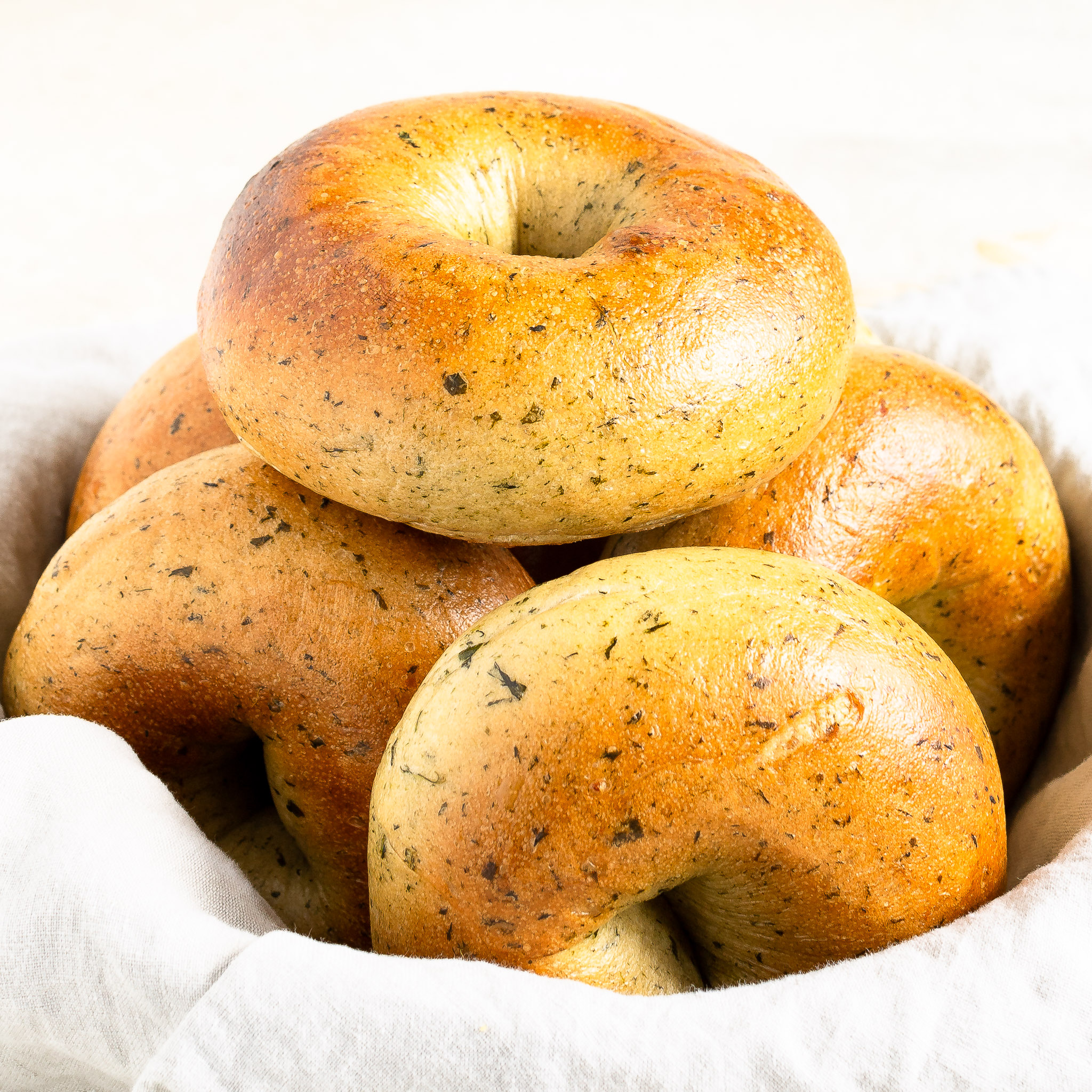
How do You Make Spinach Bagels?
What makes a spinach bagel a spinach bagel is obviously the spinach. However, what you do with it can have drastic effects on the final bagel. Here is what I have uncovered:
- Some recipes use raw spinach. There is nothing wrong with that! I chose to sauté my garlic and spinach for three reasons. First, I wanted to sauté the garlic. Doing so enhances the garlic flavor, delivering a more complex flavor. Second, sautéing the spinach in the garlic helps distribute the garlic flavor to the spinach. Third, by sautéing the spinach, we dehydrate it just a bit for a more concentrated spinach flavor.
- If you want the spinach to be marbled into the dough (as it is in the photos in this post), be sure not to overcook the spinach.
- If you want green bagels, cook the spinach down until it is thoroughly wilted.
- Want green bagels with some spinach marbled in? Cook half the spinach until thoroughly wilted and cook the other half much less.
Calculate the Amount of Water Based on the Amount of Spinach
The recipe for these spinach garlic bagels are based on my original Bagels recipe. The only difference is how we incorporate the spinach into the Bagels recipe formula. Making this recipe will require some quick math, but, I promise, it will not be painful!
Spinach is approximately 97% water. Therefore, we cannot just add spinach into my traditional Bagels recipe dough because doing so would be the equivalent of adding much more water to the dough, resulting in more of a bread than a bagel.
The way we avoid over-hydrating the dough is by measuring the cooked spinach/garlic mixture. (Yes, the garlic is a few grams, but for sake of convenience, we will just ignore that the garlic is included in the weight of the spinach.) Take that number, and multiply it by .97. The result is the amount of water in your spinach mixture. Then subtract that number from the total amount of water needed (470 grams).
So, when I made this recipe for the photos and video you see in this post, my cooked spinach mixture weighed 193 grams. 193 x .97 =187 grams, which is the amount of water in my spinach mixture. Because I need a total of 470 grams of water for the recipe, I subtracted 187 from 470:
470 – 187 = 283 grams
I therefore used only 283 grams of water when I mixed the dough.
What are the Ingredients for Spinach Bagels?
For the spinach part of the dough, you simply need:
- Spinach: Could you use more spinach than in this recipe? Absolutely. Just be sure to do the math to ensure you do not over-hydrate your dough.
- Olive oil: Just a teaspoon is needed so you can sauté the garlic very briefly.
- Garlic: Could you use more garlic than in this recipe? Absolutely. You can also use less. While you could use garlic powder in the dough, I just love the idea of using all fresh ingredients.
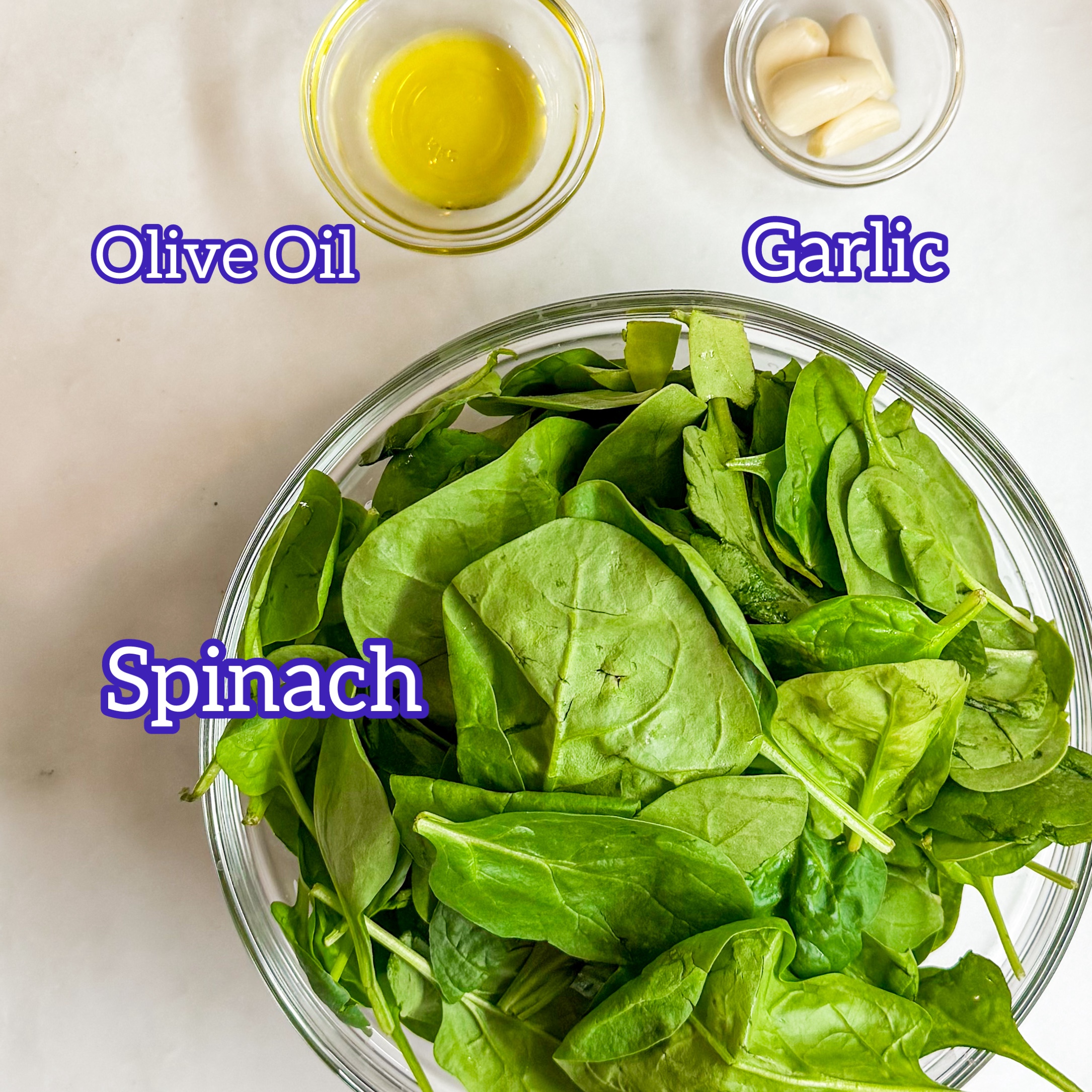
For the rest of the bagel dough:
- Bread flour: We use bread flour rather than all purpose flour because of the higher protein content in bread flour, which means more gluten development and a chewier bagel.
- Salt: Although we avoid adding the salt directly with the yeast, as it could slow or kill the yeast, when it is added into the dough after the yeast, it helps the yeast work its magic. Salt also gives bagels flavor.
- Sugar: Of course, a touch of sweetness is nice, but the sugar also helps activate the yeast and contribute to browning the bagels when they are cooked.
- Yeast: You can use active dry or instant yeast. I am a fan of instant yeast. Specifically, I have used both Fleischmann’s and Red Star. Everyone raves about Red Star, but I have found it to be hit or miss, with some jars of yeast barely alive. From my personal experience, I prefer Fleischmann’s because it never gives me any issues.
- Barley malt syrup: This is where we get the New York Bagel flavor. It can be a struggle to find it in the supermarket, so I usually just order from Amazon. For a fuller explanation and the difference between the syrup and the powder, check out my Bagels post.
- Water: Be sure to do the math once you know the weight of your spinach mixture to ensure you do not add too much water to your dough. Tip: Use cold water to the hot spinach mixture to help it cool down quicker.
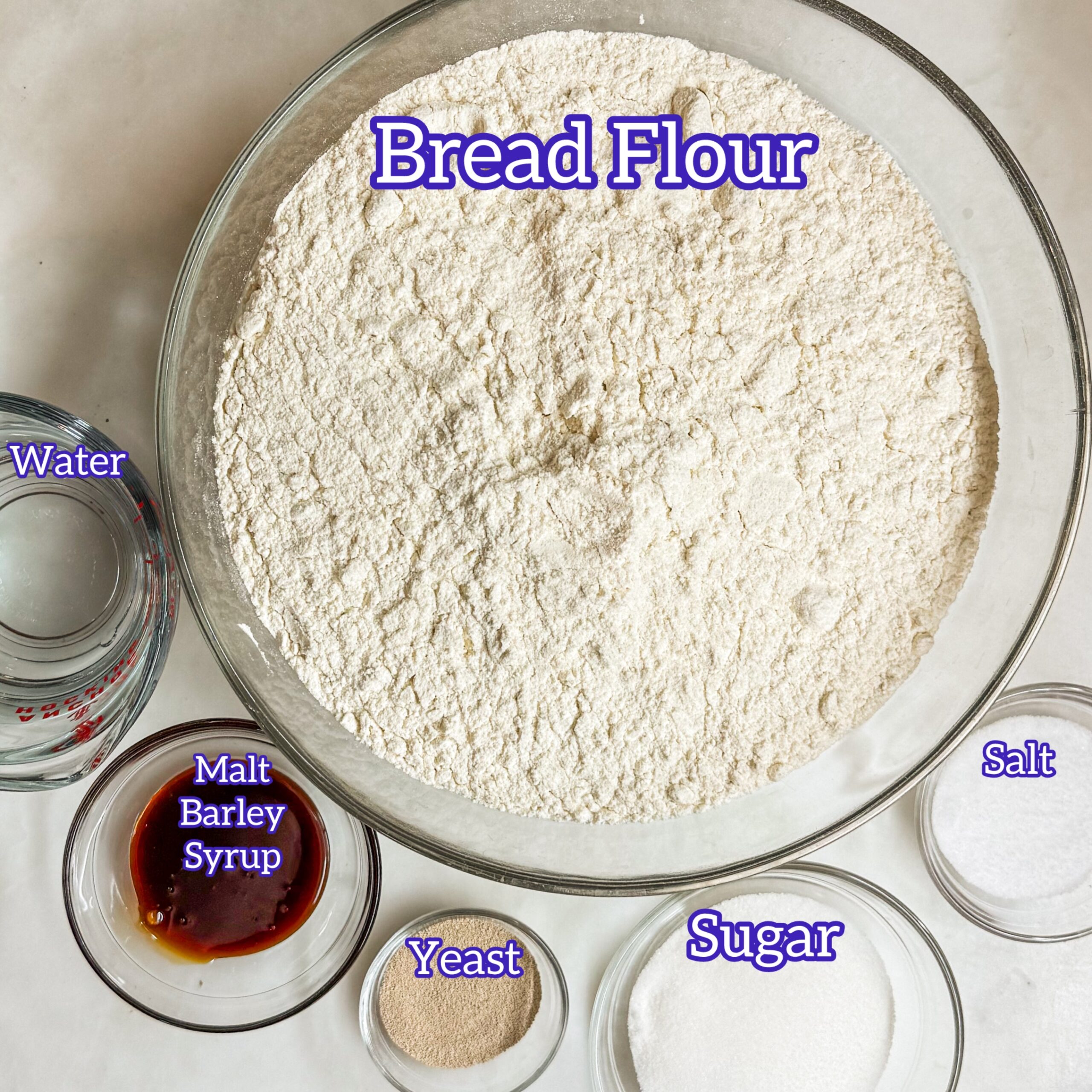
How to Make Spinach Bagels
To make any of my bagel recipes, you really need a mixer. Bagel dough is low hydration, which means it is tough to knead. It will take approximately 20 minutes of constant kneading by hand to fully develop the gluten in the dough.
With a KitchenAid 5 Quart Professional (or higher), you should have no issues kneading the dough. If you have a less powerful mixer like the KitchenAid Artisan, the dough may be too stiff and cause your motor to overheat and turn off at some point during the kneading process. If the motor sounds like it is overworking, I suggest turning it off and finish kneading by hand since it will be mostly kneaded by that point.
I recently purchased a spiral mixer, which is truly ideal for kneading bagel dough. The Famag Grilleta 5 quart has taken my bagel dough making to the next level.
Mix Spinach Bagel Dough Ingredients
Knead all the ingredients except the salt. It will take a few minutes for the dough to come together. Resist the urge to add more water. If, after about 3 minutes, the dough has not come together stop the mixer to scrape the sides of the bowl. If, after another minute, it still is not coming together, add 1 teaspoon of water. Unless you live in the dessert or it’s a particularly dry day, you should not need more water.
Knead and Add Salt
By about the 7 minute mark, slow down the mixer and start adding the salt. (Nerd alert: We wait to add the salt because salt, when first combined with yeast, can kill some of the yeast or slow the yeast development in the dough. Once the dough is formed, the yeast reacts much more kindly to the salt, and it actually helps the yeast develop.) Knead for about 5 more minutes.
Windowpane Test
Do the windowpane test to make sure the gluten in the dough is fully developed. The windowpane test means that you take a small piece of dough, flatten it out with your fingers, and gently pull the dough. If the dough pulls without ripping to the point where it is very thin and translucent, it has passed the windowpane test. If it rips easily, continue kneading, checking for the windowpane test after another minute. Depending on the weather, especially if low humidity, it could take an additional 5-7 minutes.
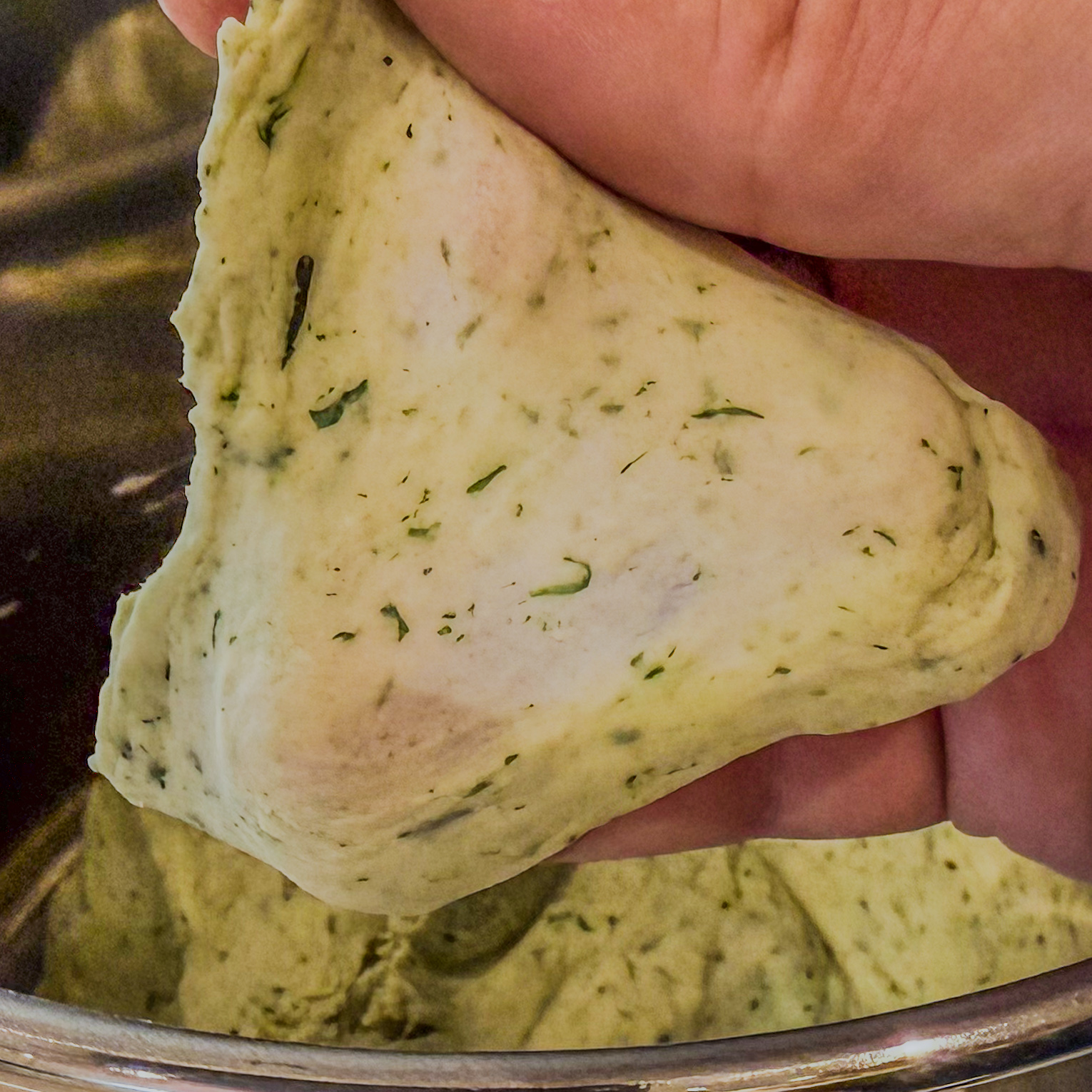
Shape and Rest
Shape the bagels. Divide them into equal portions by weight, rolling each portion into a ball and covering them with a piece of plastic wrap. Remove one ball at a time from the plastic wrap, flatten into an oval, and roll up like rolling a cinnamon roll. Use the palms of your hands to roll the dough against the countertop to shape into logs approximately 8 inches long. Cover the logs with plastic wrap and allow them to rest for 15 minutes. Then join the ends of each log, gently pinching them together. Place on a parchment lined baking sheet and cover with plastic wrap. Check out the video included with this post to see how I shape Spinach Bagels.
Refrigerate overnight
Refrigerating the bagel dough overnight slows down the fermentation, allowing the flavor of the dough to develop further. It also means you can have hot, fresh spinach garlic bagels in the morning!
Boil and Bake
Remove the bagels from the refrigerator and allow them to come to room temperature, approximately 45 minutes. In a large pot (I use a 4½ quart pot), bring water to a boil together with the malt. Boil two to three bagels at a time for 30 seconds on each side. I find using Alexa or Siri takes longer than just setting a timer, so I use a TimeStack from Thermoworks (which is where I buy my Thermapen) which lets me set multiple timers and to record my voice so I know what the timer is. (They also sell an Extra Big and Loud Timer which is also great.) Use a strainer or a skimmer to flip the bagels and to drain and transfer them from the boiling water. I would avoid using tongs, as pressing into the dough could deflate part of the bagels.
For plain bagels, drain and transfer to a parchment lined baking sheet. If you really want to gild the lily, spinach garlic bagels are great coated in Everything Seasoning. Have the Everything Seasoning set on a piece of foil on a baking sheet. Immediately after boiling the bagels, coat them in the Everything Seasoning and transfer to a parchment lined baking sheet. (Keeping the toppings on foil makes for easy clean up.) Bake for 16-20 minutes, until the bagels are golden brown.
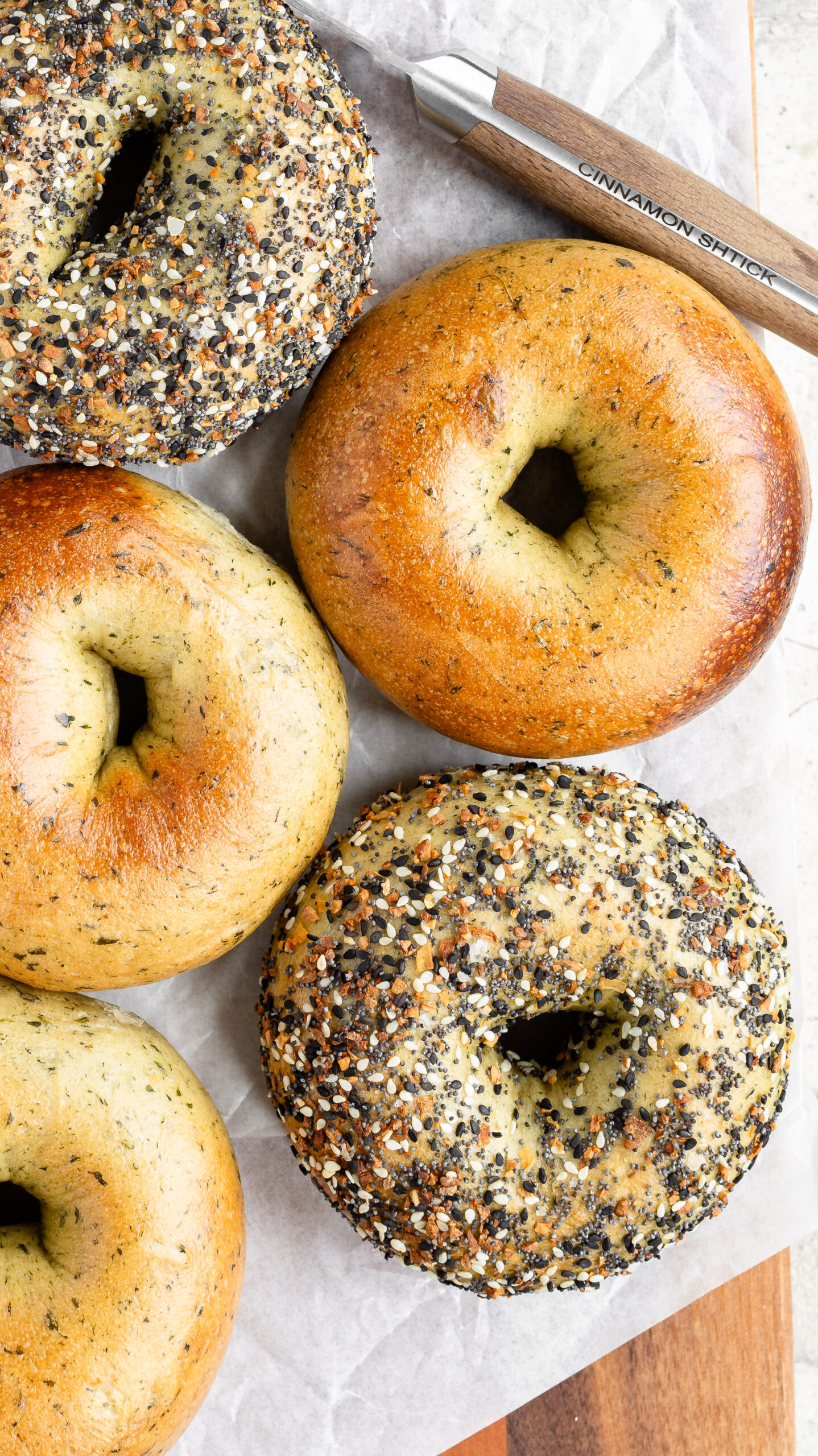
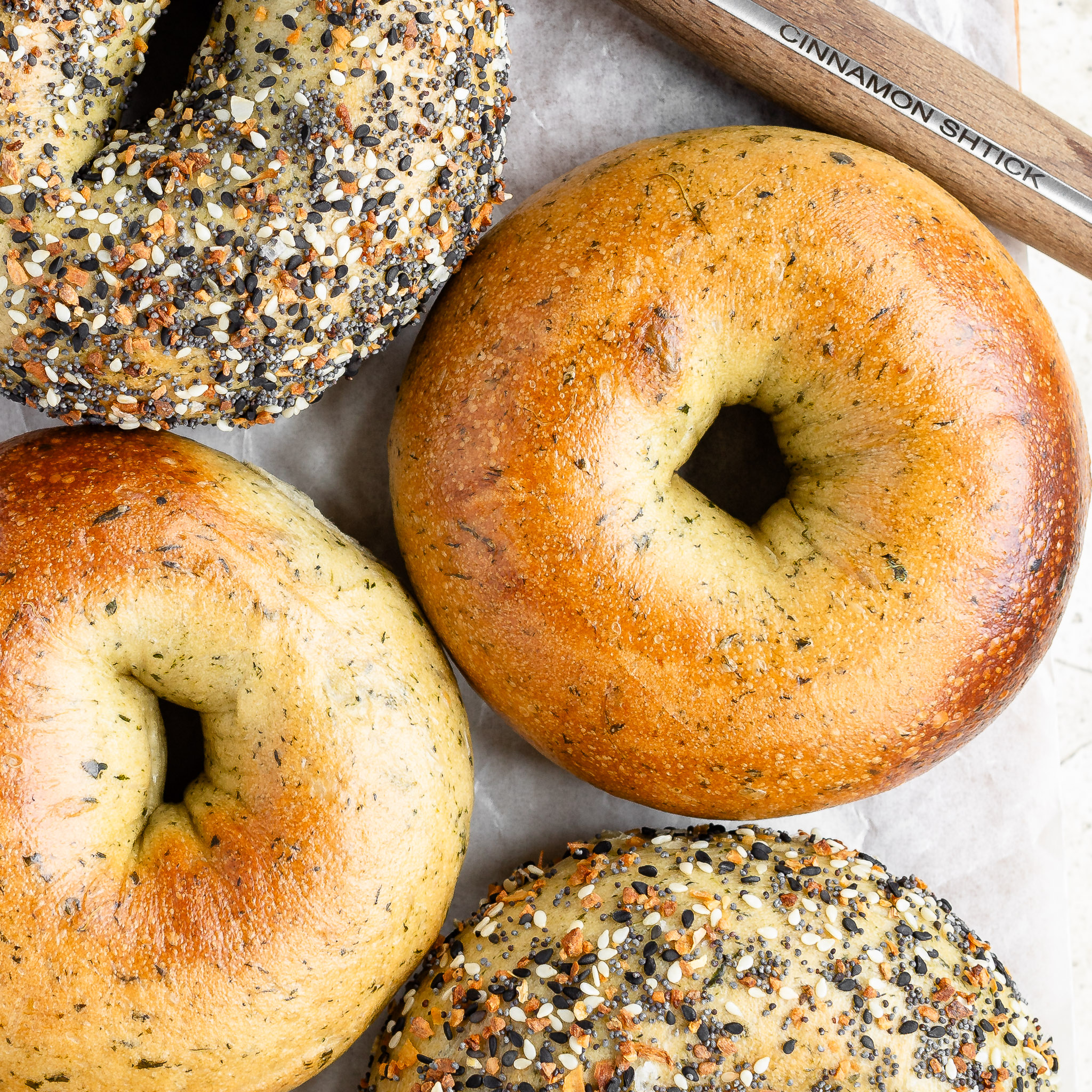
Spinach Bagels
Ingredients
Spinach:
- 142 grams spinach (5 ounces)
- 4 cloves garlic (minced)
- 1 teaspoon olive oil
Bagel Dough:
- 6 grams active dry or instant yeast
- 470 grams water (less 97% of the weight of the spinach/garlic mixture - see note)
- 50 grams sugar (divided, if using active dry yeast)
- 910 grams bread flour
- 40 grams non-diastatic malt powder, plus approximately 2 Tablespoons for water bath (if using malt barley syrup, use 20 grams in the dough and 1 Tablespoon for water bath)
- 20 grams salt
Instructions
Spinach:
- Place a heat safe dish on your kitchen scale and tare the scale so it is set to 0 grams.
- In large frying pan, heat the olive oil over medium heat, spreading it to just cover the bottom of the pan. Add the garlic and sauté for 30 seconds, stirring constantly. Do not let the garlic brown. Add the spinach, stirring constantly for 30-60 seconds. Try to avoid over-wilting the spinach. Remove from heat and pour into the prepared heat safe dish on your kitchen scale. Write down the weight of the spinach mixture.
- Multiply the weight of the spinach mixture by .97. Subtract the result from 470. The result is the amount of water to add to the spinach mixture. (For example, the weight of my spinach mixture, including any liquid from the frying pan, was 193 grams. I multiplied 193 by .97, which is 187. I then subtracted 187 from 470, which was 283. I therefore added 283 grams of water to my spinach mixture.)
Bagels:
- In a mixing bowl fitted with the dough hook, combine the yeast, water and approximately 1 teaspoon of the sugar. Gently stir to hydrate the yeast. Allow to sit until foamy, 3-5 minutes. Add the bread flour, rest of the sugar, and 20 grams malt powder or 10 grams malt barley syrup. (If using instant yeast, combine all ingredients except the salt and continue from here.) Knead on a medium-low speed for about 7 minutes. Then, with the mixer on a low speed, slowly add the salt. Once combined, increase the mixer to medium-low, and continue kneading an additional 3-5 minutes. The salt should be fully absorbed (you should not feel the salt when you touch the dough) and the dough should be very smooth.
- To make sure the gluten is fully developed, do a windowpane test. Take a small piece (approximately 1 teaspoon) of dough and stretch it between your fingers. It should form a “window pane”, meaning it should get thin enough that it is translucent without ripping. If it is not at that point yet, continue kneading in the machine at 1 minute intervals or knead by hand until it passes the test.
- Divide the dough into six equal portions, each approximately 122 grams (If you want your bagels to each be equal, weigh the full entire dough and divide the weight by 6 for the total number of bagels.) Shape each one into a ball, covering each with plastic wrap. Taking one dough ball at a time, flatten the ball with your fingers into an oval/rectangle, approximately four inches by six inches, so that the long part of the oval/rectangle is horizontal in front of you. Roll the dough up like cinnamon rolls. With the palms of both your hands, roll the dough against the countertop into a rope, approximately 8 inches long. Cover with plastic wrap. Repeat with remaining dough balls. Allow the six ropes to rest for 15 minutes.
- Attach the ends of each rope to form bagels, gently pinching the ends together. Place each bagel on a baking sheet lined with parchment paper. Place the tray, tightly covered in plastic wrap, in the refrigerator overnight.
- In the morning, remove the tray from the refrigerator and allow the bagels to come to room temperature, approximately 45-60 minutes.
- Approximately 30 minutes before you plan to boil the bagels, preheat the oven to 425°F. Line a baking sheet with parchment paper and set aside.
- If you are going to coat the bagels in seeds, arrange them on a foil lined sheet and set aside.
- Using a pot large enough to comfortably hold 2 or 3 bagels at a time, bring a pot of water with 2 Tablespoons of non-diastatic malt powder (or 1 Tablespoon barley malt syrup) to a boil. (I use a 4½ quart pot and fill it up approximately half way with water.) Place 2 or 3 bagels at a time into the boiling water for 30 seconds. (See note, below, if the bagels are sticking to the parchment paper.) Flip each bagel and boil for an additional 30 seconds. Using a strainer or a slotted spoon, remove each bagel from the water and place on sheet with seeds, coating each bagel with seeds. Place bagels on the prepared baking tray. Repeat with the rest of the bagels.
- Bake the bagels for 16-20 minutes, until the tops are browned.
Notes
- To calculate the amount of water you need, multiply the weight of the spinach mixture by .97. Subtract the result from 470 (the total amount of water). The answer is the amount of water to add to the spinach mixture which is the total amount of water for the recipe. Read the above post for a fuller explanation.
- You can easily halve this recipe to make 6 bagels, and I highly recommend you do so if you are using a KitchenAid Artisan mixer. If halving, use half the amount of spinach, garlic and olive oil, and be sure to reduce 97% of their final weight from 235 grams of water to calculate the amount of water to add.
- Feel free to use even more spinach or garlic than the recipe calls for. Play with the formula to achieve your desired flavor profile.
- Some people spread corn flour or semolina flour on the parchment paper before placing the bagels on the baking sheet before refrigeration to prevent the bagels from sticking to the parchment paper. If the bagels stick to the parchment paper just prior to boiling, I prefer to avoid the additional mess and instead just cut the parchment paper into squares (each square holding a bagel) and boil the bagels with the parchment squares on them. After a few seconds in the boiling water, you can easily remove the parchment with tongs.
- Once baked and cooled, the bagels can be stored in the freezer for months. I recommend slicing them before freezing. To defrost, wrap each bagel individually in foil, place in cold oven, and turn oven on to 350°F. Within a few minutes of your oven reaching 350°F, your bagels should be defrosted and nicely warmed, begging for butter to be shmeared all over them.

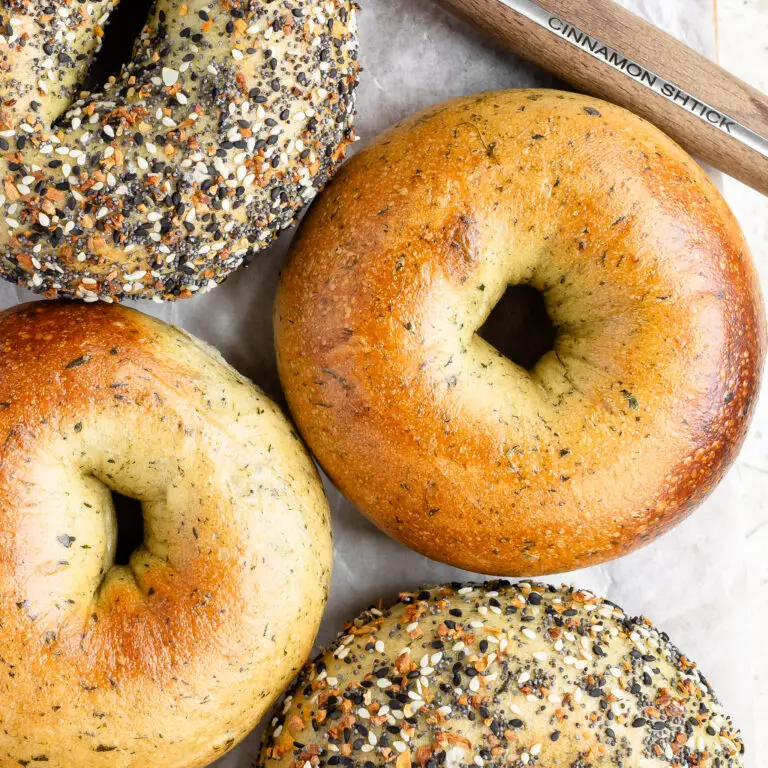
4 Comments
These spinach bagels were amazing! I love a good hidden veggie moment.
Spinach bagels is delicious perfect shape I enjoyed it, I have made it for our breakfast.
These spinach bagels are so delicious! Love adding some veggies into my breakfast.
Yum! These were so good and loved your detailed instructions like “window pane” to help me know what I was looking for. I’ll definitely be making these again!